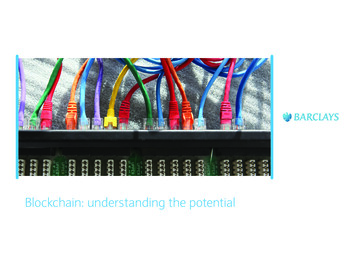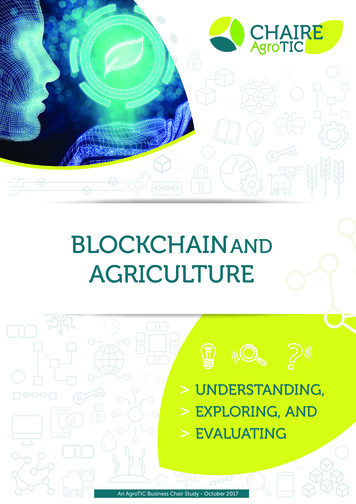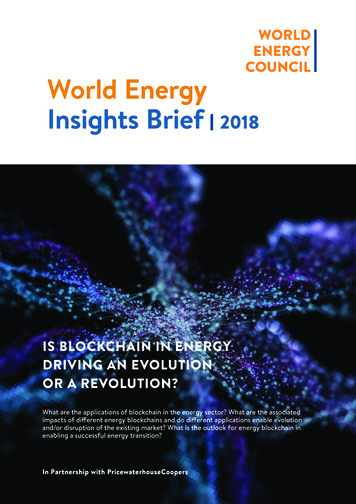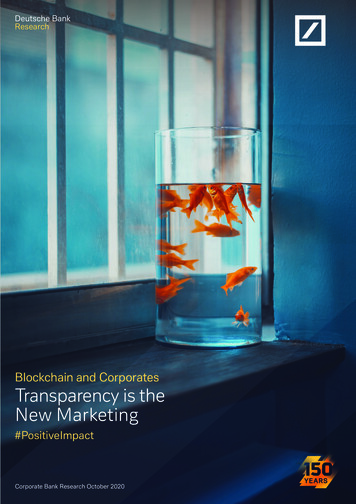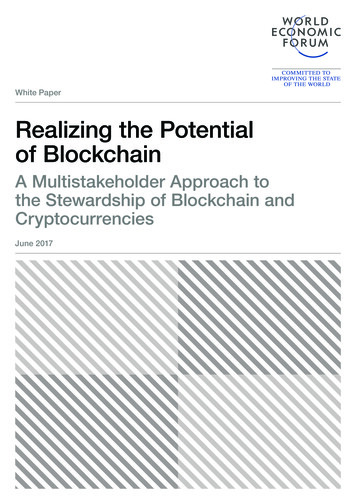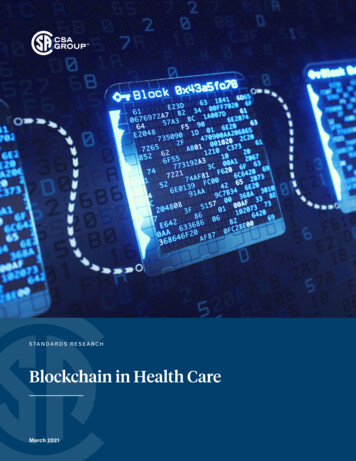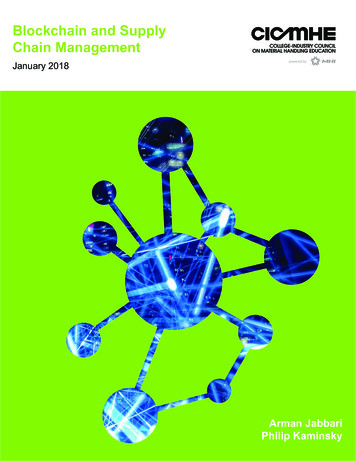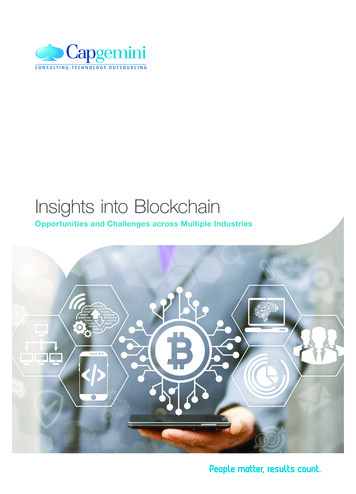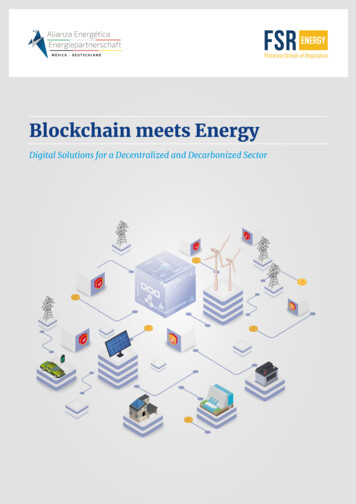
Transcription
Blockchain meets EnergyDigital Solutions for a Decentralized and Decarbonized Sector
ImprintPublishersGerman-Mexican Energy Partnership (EP) and FlorenceSchool of Regulation (FSR).The German-Mexican Energy Partnership is an initiativeby the Federal Ministry for Economic Affairs and Energy(BMWi) and the Ministry of Energy of Mexico (SENER).It is implemented by Deutsche Gesellschaft fürInternationale Zusammenarbeit (GIZ) GmbH.ContributorsViktor Peter (GIZ Blockchain Lab)Juan Paredes (InterAmerican Development Bank, IDB)Moisés Rosado Rivial (GlobalGrid)Eduardo Soto Sepúlveda (Phineal)Diego A. Hermosilla Astorga (Phineal)Design and Productionwww.sk3.mxStatusJune 2019Photography and illustrationShutterstock 1087535381 by everything possible (p.7)Shutterstock 1402577345 by Andrzej Golik (p.10)Shutterstock 88274602 by grossishut (p.14)BMWi (p.17)Shutterstock 226279111 by Stefano Ember (p.20)Shutterstock 549247237 by Fabian Plock (p. 30)All rights reserved. Any use is subject to the consent of the EP secretariat and the FSR.All content has been prepared with the greatest possible care and is provided in good faith. The assumptions, viewsand opinions expressed do not necessarily reflect the official policy or position of neither the Federal Ministry forEconomic Affairs and Energy of Germany (BMWi), the Ministry of Energy of Mexico (SENER), the EP secretariat andthe FSR.Information is provided in summary form and is therefore intended for general guidance only. It is not intended tobe a substitute for detailed research or the exercise of professional judgement. The property of each contributioncorresponds to its author. The authors and entities involved provide no guarantee regarding the currency, accuracy and completeness of the information provided. They accept no liability for damages of a tangible or intangiblenature caused directly or indirectly by the use of or failure to use the information provided.
Contents01Contents1.Acronyms .2Foreword EP.3Foreword FSR.5Blockchain in the energy sector – An introduction to the technology and its potentialsViktor Peter, GIZ Blockchain Lab.62. Digital innovation for a 100% renewable energy worldJuan Paredes, InterAmerican Development Bank.133. Blockchain and renewable energy – An overview of the opportunities for MexicoMoisés Rosado, GlobalGrid.194. Sello Sol & Blockchain GTIME – Electricity traceability system using blockchainEduardo Soto Sepúlveda and Diego A. Hermosilla Astorga, Phineal.295. Contributors.41
02AcronymsAcronymsAIArtificial intelligencekWKilowattAIEElectricity and Electronics IndustryAssociation (Chile)kWhKilowatt hourM2MMachine to machineAPIApplication programminginterfacesMWMegawattBanxicoMexico’s Central BankMWhMegawatt hourCECClean energy certificatesP2PPeer-to-peerCFEFederal Electricity f-stakeCNBVNational Banking and SecuritiesCommission (Mexico)PoWProof-of-workCNENational Energy Commission(Chile)PVPhotovoltaicCoDiCobro Digital (Mexico)SDGsUnited Nations SustainableDevelopment GoalsCREEnergy Regulatory Commission(Mexico)SENNational Electric System(Chile)dAppsDecentralized appsSENERMinistry of Energy (Mexico)DERDistributed energy resourcesTWhTerawatt hourDLTDistributed Ledger TechnologyUSDUnited States DollarsDSRDemand-Side ResponsevRESEPGerman-Mexican Energy PartnershipVariable renewable energysourcesEUEuropean UnionWhWatts hourEVsElectric vehiclesFSRFlorence School of RegulationGHGGreenhouse gasGWGigawattIDBInter-American DevelopmentBankIoTInternet of ThingsITInformation Technology
Foreword EP03Foreword EPThe global market for blockchain technology was at only1.2 billion USD in 2018. Still, the hype is high when itcomes to “blockchain” – a technology which has gaineda lot of attention. From governments to start-ups, fromutilities to academia and civil society organizations – allare stepping into a digital era in which blockchain is bestknown by cryptocurrencies like Bitcoin. But blockchainis much more than cryptocurrencies. Blockchain, adistributed ledger technology (DLT), offers many possibleuses to governments, society at large and businessesspanning across different areas: inter-companytransactions, taxation, supply chain management,peer-to-peer trading (P2P), Internet of Things (IoT),Demand-Side Response (DSR), carbon - offset trading,just to name a few.Global revenues of blockchain technology is forecastedto have significant growth in the coming years, beingexpected to climb to more than 23 billion USD in 2023.The largest share will come from the financial sector,closely followed by the energy sector.Size of the global blockchain technology market 2018-2023 (billion USD)Source: Statista, 2018However, it is not just the potential economic impactthat makes DLT so interesting, it is because a numberof existing blockchain applications have demonstrateddirect or indirect impact on the achievement the UnitedNations Sustainable Development Goals (SDGs). This is akey factor for international cooperation.In that sense, the EP provides insights about and, ifbeneficial, support for DLT use cases in the energysector. An energy sector that is rapidly changing from ananalog world of a highly centralized, fossil fuel-basedgeneration and transmission system to a new paradigmof decarbonization, decentralization, and digitalization(3D s). New challenges within a future electric systemwill be defined by a high percentage of renewables and1customer-sited smart technologies, such as rooftop solar,behind-the-meter energy storage, electric vehicles,smart thermostats and more. In a world with residentialprosumers, distributed energy resources (DER), digitaltechnologies and increasing shares of renewables,especially utilities, system operators and regulators areleft with new tasks.Together with key energy sector stakeholders weorganized an international experts’ event on “Blockchainmeets Energy”1, which shed light on possible and alreadyimplemented blockchain applications. Impressiveinternational use cases were outlined: public serviceoperations; certification and tracking schemes;distributed and microgrid solutions; IoT; as well as free,“Leveraging digitalization – Blockchain meets Energy - Workshop on blockchains in the electricity sector” Mexico City, November14th & 15th, 2018.
04Foreword EPopen-source scalable blockchain platforms specificallydesigned for the energy sector’s regulatory, operational,and market needs.Now we are partnering with the renowned FSR to makesome of those insights known to an even wider audience.It should help to get a better understanding of what DLTare and what they are not; what their potentials andwhat already existing applications are. This is extremelyimportant, because while the pro-blockchain communityargues that it will be nothing less than a revolution to thefabric of our society and economy, skeptics see it as anoverblown hype pointing towards existing solutions suchas clouds, cryptography or simple databases.But what if we see blockchain as a solution to the 3Denergy world of the 21st century, rather than a disruptionitself? “When we do, we can seize the possibilitiesblockchain offers: a way to make a decentralizedelectricity grid more secure against cyberattack byeliminating vulnerable, centralized single points offailure; a way for millions—and eventually, billions—ofDERs to connect, verify, and transact with one another;a way for the green attributes associated with renewableenergy to be tracked and traded with unprecedented levelsof transparency and automation, streamlining costs andenabling greater market participation; a way for electricvehicles (EVs) to become cooperative and interactive gridassets, rather than dumb sources of spiking grid demandthat exceed circuit capacities” (Bronski, 2019).Enjoy the reading!Josche MuthCoordinator of the Secretariat of the German-MexicanEnergy Partnership
Foreword FSR05Foreword FSRThe FSR partners with the EP. Why?Because understanding “blockchain”, its nature andpotential, has become a duty for a school like us, offeringan energy policy and regulatory knowledge hub to bothenergy practitioners and academia. Giving a neutral accessto the facts and to the truth, in a world of continuouslytwisted information by particular interests, strategiclies and fake news, or sincere misunderstanding andconsequential ignorance, is a core duty of the FSR.In November 2018, FSR took part in the honest andincredibly valuable “Blockchain meets Energy” workshopin Mexico, organized by the German-Mexican EP,and thought it would be of the highest interest for ouraudience, either in Europe or worldwide, to get access tothe high-level exchanges among its many participants,from the Americas or Europe.Here it is.# Victor Peter (GIZ Blockchain Lab) introduces themattewr by explaining, in really simple words, whatblockchain is and is not; the numerous types of variants itcan give birth to, notably the “public” and the “private”;what is the best use of each variant; and why not to useblockchain when traditional tools, as simple data base, arebetter.#Juan Paredes, from the Inter-American DevelopmentBank, provides a nice transition between Victor’sblockchain introduction and the coming contributionsapplied to Mexico and Chile. Juan shows whyblockchain has a very special and crucial role toplay to accelerate energy transition by simplifyingdecentralized transactions and securing identificationand measurement. Blockchain is an enabling technologythat can empower many new players entering in adeep ‘energy paradigm shift’ linking digitalisation todecarbonation via decentralisation.# Moisés Rosado Rivial (Global Grid) reviews theopportunities for blockchain in the Mexican renewableenergy market. Creation of prosumer-centered marketplaces; use of automated smart contracts to buildcrowdfunding platforms feeding solar projects; issuingand following up clean energy certificates (CEC) nurturinga traceable exchange.# Eduardo Soto Sepulveda and Diego A. HermosillaAstorga (Phineal) describe the development of anelectricity traceability frame where blockchain technologypermits to identify and measure individual electricityinjections and withdrawals, to calculate every 15 minutesthe losses incurred, and to feed an automated smartcontract settlement and payment for green electricity.As you can see, and as we use to say at FSR, technologyenables and does not dictate what to do with it.Blockchain technology is decentralization friendly andpermits many novelties that were only dreams 10 yearsago. Which ones? Innovators, projects and pilots will testand tell. Innovations like the ones discussed from Mexicoand Chile also show that the 21st digital century will bemade by the humans investing in it. And that leapfroggingNorth America or “Old Europe” is always doable: onlya matter of will, efforts, consistency, time, and sense ofopportunity.Jean-Michel GlachantLoyola de Palacio Chair holder & Director Florence Schoolof Regulation (European University Institute)
06Blockchain in the energy sector1. Blockchain in the energy sector – An introduction to thetechnology and its potentialsViktor PeterGIZ Blockchain LabIII. The transformation of the energy industryThe energy industry is currently undergoing a doubletransformation: in addition to the energy transitiontowards renewables, digitalization is changing the basisof the value creation in the sector. With blockchain,the energy industry is also obtaining a new promisingtechnology that is currently on everyone’s lips. Expertsassume a potential for innovation and change comparableto the triumph of the Internet. The development of evernew applications based on blockchain technology andnumerous projects by energy suppliers underline the highdynamics and the associated expectations.IV. About blockchainI. AbstractWhat the blockchain is notThe digitalization of the energy industry is continuingAt the latest since the rapid rise of the cryptocurrencies,to gain momentum. Blockchain2 technology, whichcan bring far-reaching changes in the energy sector,is currently emerging as a new driver of this rapiddevelopment. Blockchains are a special kind of datamanagement system that identifies and tracks changes(transactions) within the system digitally and shares thisinformation with the distributed computers connectedto the network. These computers check and add newentries (transactions) into the ledger if proven correct bythe majority of the computers connected to the system.Cryptographic encryption, transparency and economicincentives keep any malicious computer from enteringwrong new entries.Blockchains have the potential to optimize energymanagement processes in almost all stages of the valuechain and at the same time to cope with the growingcomplexity in the increasingly decentralized energysystem. Even if the general conditions for blockchainprojects are very different in the international context,the basic application possibilities are similar. Inorder to really be able to use the actual added value ofthe technology, however, it is necessary to considerfundamentally new, decentralized structures – towards alike Bitcoin or Ether, the topic blockchain has alsomoved into the focus of media reporting. In manycases, however, the functionality and properties of theblockchain technology are shortened considerably orincompletely reported. Therefore, as a first step it makessense to understand what the blockchain is not.A blockchain is not the “one” blockchain. There areseveral hundred different blockchains, which differ intheir decentralization, their consensus mechanism ortheir access. In addition, the majority of blockchains runcompletely autonomously from other blockchains, whichmeans that different blockchains cannot communicatewith each other, i.e. they cannot exchange data.Blockchain is not Bitcoin and Bitcoin is not equalto blockchain. Bitcoin is a cryptocurrency that usesblockchain as its technological base. It is therefore anapplication on a blockchain, but by far not the onlyconceivable application scenario. In addition, it is ofcourse not the only crypto currency: there are more than athousand of them. And a blockchain does not necessarilyneed a currency, especially private blockchains oftendo not use a crypto currency. In public blockchains, onblockchain thinking.the other hand, these currencies serve as an incentiveII. Key wordscorrect behavior or the provision of computing powerDLT, blockchain, energy, certificate, wholesale, tradingmechanism to attract more participants and to rewardwithin the blockchain with “monetary” values.A blockchain is not the same as a database. One of thecentral strengths of the blockchain is its decentralization,2Blockchains are a kind of DLT. A DLT does not have to be a blockchain, though. In the following, however, the terms areused synonymously.
08Blockchain in the energy sectorwhich also distinguishes it from traditional databases.been possible for the first time to replace central actorsWith classical ledgers, the security challenges are growingsuch as banks. Because technology creates the trust andas more participants have the right to change data records.functionality that was previously ensured by these centralWith a (public) blockchain, on the other hand, moreinstitutions.participants provide increasing security because theycheck each other in consensus for the correctness of newdata entries.Development of the technologyThe Bitcoin blockchain is the world’s first blockchainBlockchains are also not a standalone-solution. Onlyto run since 2009. It and its clones – the code is openin combination with other digital technologies cansource and has been used with modifications in otherblockchains generate a high added value as a trustworthyblockchains – are considered first generation blockchains.infrastructure. An example from the energy sector couldThe transactions within these blockchains are primarilyillustrate this statement: generation facilities suchdesigned for the exchange of financial assets. In theseas PV rooftop units can document the quantity of theblockchains, any person or company under a pseudonymelectricity generated directly into a blockchain through a(wallet number, similar to a bank account number) couldterminal device connected to the Internet. This providesand can take over any role within the system withouttamperproof documentation of any electricity fed in orprior verification. Popular examples of this generation areconsumed. However, it is critical to ensure that the devicesBitcoin, Litecoin and Dogecoin.that enter data into the blockchain are set correctly.Plausibility checks, i.e. data analytics, can also help toidentify incorrect sources of information. Otherwise,there is a danger that incorrect data will be written intoa blockchain that does not capture actual conditions. InInformation Technology (IT), this is also referred to as the“garbage in, garbage out” problem.What the blockchain isWith the second blockchain generation, primarilydriven by Ethereum, intelligence, applications andautomation were introduced into the blockchain space.This allows information, “self-executing contracts”(smart contracts) and complete software programs(decentralized apps, dApps) to be operated in theblockchain. Thus, the representation and transactionwithin the blockchain is no longer limited to financialassets. Rather, any information can be displayed andIn general, and in very simplified terms, a blockchaintransferred, such as certificates, image rights, shares oris a growing file that contains all the transactions (dataeven electricity deliveries.entries) that have ever been entered on it. However, thisfile is not stored on a central server, but on the computersof all participating players. New transactions, i.e. dataentries, are added by consensus in an automated approvalprocess between the participating computers. For this, themajority of the “votes” of the connected computers in theblockchain network is needed.The latest developments are moving further and furtheraway from the principle of a blockchain, in which severalhundred individual transactions are packed into one blockand chained to the previous block. The background to thisapproach were considerations of velocity of the wholeprocess. If a global network of computers has to checkevery single transaction and not a bundled number ofThis mode of operation gives origin to two centraltransactions (in a block), the verification of entries takesinnovative properties that have been made possible byfar too long. For example, in the Bitcoin blockchain, ablockchains. First, there is the issue of data sovereignty,new block with around 1000 transactions is created everyi.e. the user control over data that is released. Blockchain10 minutes. If only one transaction were verified everytechnology has made it possible to make data records10 minutes, the procedure would be much too slow and(about currencies, image rights, but also kWh) on theinefficient. However, new technological developmentsInternet unique and non-copiable. This also goes hand incan now circumvent this problem and enable individualhand with the transparency on which the technology istransactions to be displayed in a DLT without the virtualbased: because everyone has the same data set, it is alwayscreation of blocks. As a result, speed and scalability mightpossible to see who is holding which good. Of course,increase with no transaction costs involved.there is no need to provide the real name of a participantin the system for this. Changes in possession are locatedin a wallet, a digital account book, that is just a string ofnumbers and that does not provide the name of the owner.The second big novelty that blockchains bring withthem is their ability to create trust for actors who do not(have to) know each other. With this technology, it has3One representative of these new approaches is IOTA3 withits concept of the tangle. Put simply, the principle of thisapproach is based on the following: if you want to makeone transaction, you have to confirm two transactionsthat have not yet been confirmed by the attached networkof computers. The technology behind IOTA promises tobe used as an operating system in the IoT. Among otherThe IOTA protocol is a distributed ledger technology developed by the IOTA Foundation.
Blockchain in the energy sector09things, it should make it possible for machines not only tomust be attacked during manipulation attempts is smallercommunicate with each other, but also to automaticallythan in public blockchains. Establishing and operatingpay for services. An example would be an electric car thatproprietary private blockchains or licensing modelsagrees with a charging station on a price for a chargealso entails specific investments with a correspondinglyand pays via IOTA, while recording on the ledger whatgreater financial risk than using existing (open source)quantities have actually been charged.solutions. Private blockchains are well suited not onlyfor use with in-house processes designed for high dataDifferent access, different blockchain, differentbusiness modelsAs already mentioned, there is not “one” blockchain.Many types of blockchain coexist, all with their specificcharacteristics. Therefore, each type of blockchain hasits own set of particular advantages and disadvantagesand is suitable for different applications. Regardless oftheir technical differences, the following statement canbe made for each blockchain: a distributed system whichprovides a tamperproof log that records all changes.throughput, for example, but also for applicationsrequiring a high level of trustworthy transparency fordifferent actors, which can be ensured by the blockchain.Consortium blockchains are, as semiprivate blockchains(shared permissioned blockchains), a compromisebetween public blockchains and private blockchains.Consortium blockchains are limited with regard tothe extent to which they can be scaled up: both theparticipating computers and the authorized applicationsrequire the approval of the entire consortium. On theother hand, this kind of approval, subject to checks, isOne crucial aspect in categorizing blockchains is howvery attractive for companies. Consortium blockchainsaccess to them is managed. A distinction is generallywill have to show how this can be combined with thedrawn between public (permissionless) and privatecounteractive limitations on expansion by focusing on(permissioned) blockchains. Hybrid solutions are knownspecific individual applications on the one hand, and onas consortium (shared permissioned) blockchains.the goal of achieving high appeal through the reach of theToday’s most popular blockchains, such as Ethereumplatform approach on the other. Some experts currentlyor Bitcoin, are “permissionless,” in other words, public.predict a promising future for the hybrid forms consistingAnyone can participate in the blockchain with his or herof different blockchain types.computer and mobile devices. Public blockchains arebased mainly on the proof-of-work (PoW) consensusmechanism to add new data entries in the ledger. Orto frame it differently: for creating new data blocks.In this consent mechanism, the computers involveddeliver more or less a PoW undertaken to generate a newThe three blockchain categories offer associatedadvantages and disadvantages and are, therefore, ideallysuited for different applications in the energy sector. It iscrucial to understand which type of blockchain fits whichspecific process, model, or service.block. Public blockchains currently have considerableIn the future, the importance of interoperability betweentechnical limitations, especially in terms of speed.different blockchains (public, private, and consortium)Unrestricted access and governance issues also preventis set to rise. It is also becoming increasingly useful tosome corporations from using this kind of blockchain.link blockchains from different sectors (energy, banking,However, public blockchains are highly secure thanksinsurance, health, and automotive industries, forto their architecture and number of participants. Andexample). Achieving this interoperability is regarded asparticipating in a public blockchain is relatively easy andone of the key success factors for blockchain technology.involves low initial investment.With private (permissioned) blockchains, the accessof participants to the blockchain can be managedIn which scenarios does blockchain show itsspecial value?by a central authority. Accordingly, the consensusThe question of whether a blockchain makes sense formechanism can be structured differently. Generatingan energy industry application is often not a technicalnew blocks or single transactions is handled using theone at all. Rather, a closer look at the specific applicationresource-saving proof-of-authority (PoAu) approach,scenario with its economic, regulatory and ultimatelywhere a single, previously specified or randomly pickednon-digital technological challenges is the necessary firstparticipant (authority) generates new data blocks. Privatestep. Only then it is possible to clarify whether blockchainblockchains are, by definition, limited when it comes totechnology offers added value in new projects and, if so,expansion, because actors must be picked or fulfil somewhich one.specifications to be added to the network. However,this enables applications to be developed and used veryquickly, as the partners are known in private blockchains.Yet, the high level of efficiency in private blockchainsalso means that the number of connected computers thatThis calls for completely new approaches in order to fullyexploit the advantages of a decentralized, tamper-proofdatabase. If, on the contrary, known solution models areused for existing problems and the blockchain is only
11Blockchain in the energy sectorsqueezed into existing systems, the full potential of thetechnology may be wasted. Such projects deliver littleadded value and, especially in competition with existingsystems, such as classical databases, do not always haveblockchain to map even the smallest transactions in aneconomically efficient manner means ultimately newdegrees of freedom for the entire sector; for example, forthe provision of balancing energy, for direct electricityan advantage.trading between private market participants and alsoA blockchain-based solution is advisable if there isblockchain basis are currently found in all areas of thea need for an identical database with a large numberof participants pursuing different interests. If thereis further need for common participation rules, thedocumentation should be transparent and unchangeableand if the transaction rules do not change constantly, afor shared investments. Accordingly, pilot projects on aenergy value chain.At the moment, two particular use cases seem to befocused by many players as they appear to be the lowhanging fruits for blockchain applications: greenblockchain solution makes sense.electricity certificates and electricity wholesale trading.If, on the other hand, a limited number of knownas electricity trading, is that the participating electricityparticipants are to use a common database, or if otherpoints mentioned above do not apply, a classical, centraldatabase can also be the best solution. The use of ablockchain or DLT in general and related investmentsshould then be well considered or at least open otherbusiness opportunities.Applications for the energy sectorOne can assume that after the financial sector, energywill be another sector that blockchains will massivelychange. In the financial sector, the blockchain has thecharacteristic that it can potentially replace centralThe prerequisite, for both green energy certificates as wellgenerators have installed smart meters that communicatevia the Internet. They provide data on the quantity andprice of the energy transmitted for trading issues or createa certificate for green energy production. The informationabout these events can then be stored on the blockchain.Therefore, both models cannot be implemented withoutdigital hardware that bears the corresponding costs.Both cases rely on smart meters and smart contracts:potential transactions are carried out based on smartcontracts, while smart meters provide the data for them.In these contracts, the parties agree when they will tradeelectricity or certificates at what price and how the energytrust bodies such as banks or insurance companies,or the certificate will be paid.which have hitherto played a decisive role within theGreen electricity certifi
The global market for blockchain technology was at only 1.2 billion USD in 2018. Still, the hype is high when it comes to “blockchain” – a technology which has gained a lot of attention. From governments to start-ups, from utilities to academia and civil society organizations – all are stepping into a



